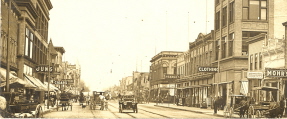SHEBOYGAN HISTORY

SHEBOYGAN HISTORY |
 |
|
| Home | Yearbooks | Students | Biographies | History | Phone Books | Churches | Pictures | Links | ||
John M. Groeneveldt, Page 405
JOHN M. GROENEVELDT has been a resident of Sheboygan County for about forty-five years, and has long been considered one of the most progressive farmers of Lima Township, his home being situated on section 15. He is the eldest of eight children, and was born in Holland, January 12, 1830. Four of his brothers and sisters are still living: Mellee, who lives in California; Henry, a successful farmer living near Sheboygan Falls; Seward, who was a soldier in the late war; and Ralph, a shoemaker by trade, and a resident of Michigan. Gertrude, deceased, was the wife of Vincent Merritt, a carpenter. Our subject's father, who bore the name of Mellee T. Groeneveldt, was born in Holland in 1802, and always followed agricultural pursuits. He was educated in his mother country, where he married Geraldina Margarita Refekes, who was a native of the same place. The father died December 13, 1885, and the mother passed away at the age of thirty-seven years. In April, 1847, the family set sail for New York and after a voyage of forty-nine days on the Atlantic, arrived safely in New York, from where they proceeded to Milwaukee. From that city they came to Sheboygan County by way of Port Washington, the trip being made overland and through the wilderness, as this was before roads had been laid out. The father pre-empted eighty acres of wild land in a region so thickly covered with timber and brush that they got lost in going to it. The first home of the family, in which they lived for four years, was a rude log cabin, the roof of which was made of logs, covered with moss, and the floor was the bare earth. Many of the hardships and trials of those pioneer days are yet fresh in the mind of our subject, and he well remembers when Indians often came to their pioneer home. Sheboygan was a small town, without a brick building in the place, and most of the business was done on Pennsylvania Avenue. Thickets and brush were plentiful, and next to the large stone Catholic Church on Eighth Street, Mr. Groeneveldt has cut cord-wood at two shillings a cord. The father lived on his homestead for many years, and then went to Oostburg, where his death occurred. He was a man respected for his integrity and industrious life. A young man of eighteen years was John M. Groeneveldt when he landed in America. The whole family then possessed only $200 in cash, which was a small sum for foreigners in a strange land. From his early years he has been accustomed to hard work, and helped to clear the farm where he first located. For several years after his arrival he dutifully assisted his parents in earning a livelihood, and he has truly seen the hardest of pioneer life. Before leaving his native land he had earned $1 per week, and was there educated in the Dutch and English languages. On August 1, 1858, Mr. Groeneveldt wedded Miss Carlena Brownrigger, a native of Germany, born February 26, 1839, and of this marriage has been born three sons and six daughters, all living: Mellee, a merchant of Minnesota; John, who is at home; Mary, wife of Mr. Kampmann, a farmer; Chrisacintia, wife of George Miley; Henry, who is at home; Gertie, now the wife of John Welsh; Carrie, Rosa and Julia, who still reside with their parents. The beautiful homestead owned and cultivated by our subject consists of ninety-nine acres of highly improved land, on which is a commodious country residence, and in addition to this he owns two and a-half acres of land in Lyndon Township. By the exercise of industry and energy, he has acquired a goodly fortune, and is classed among the best and most practical farmers of his township. In politics, Mr. Groeneveldt is a Democrat, and first voted for Franklin Pierce, but he is a man who is sufficiently independent to vote for good men, regardless of party lines. He is a true friend to the public schools and all public measures which are beneficial to the community at large.
|
||
| Copyright © 2009 www.sheboyganhistory.com - All Rights Reserved. |